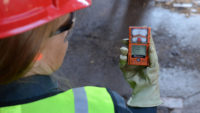ExxonMobil considers aerial methane gas monitoring

Since 2017, ExxonMobil has expanded its U.S. methane leak detection program, committed to its first global methane target, supported methane monitoring technology innovation and encouraged EPA to regulate methane emissions at new and existing sources. Although the Environmental Defense Fund (EDF) and ExxonMobil are not always aligned on certain important issues, the organizations are working together to understand and reduce methane emissions. Ben Ratner, senior director with EDF+Business, interviewed Matt Kolesar, regulatory manager at ExxonMobil’s XTO Energy affiliate, to discuss the company’s perspective on why methane is such a key issue for the industry and how technology and regulation can accelerate industry’s progress.
It’s been a busy couple of years for ExxonMobil ramping up its commitments and positions on methane emissions. What are the benefits to industry of minimizing methane emissions?
“We are taking these actions because we see multiple benefits for society, our industry and the company.
First, we want to support the future role of natural gas by reducing the carbon-equivalent footprint of the fuel. The International Energy Agency projects natural gas playing an increasing role within the world’s future energy mix over the next 20 to 30 years. Natural gas burns cleaner and has greenhouse gas benefits over coal, and mitigating methane emissions further reduces greenhouse gas emissions.
“Mitigating methane emissions helps meet societal, investor and customer expectations for cleaner energy. As the global population rises and economic development and prosperity expands, our view is that all viable energy sources will be needed to meet growing demand.
“Our challenge is to provide affordable energy supplies at the scales required, while addressing environmental concerns.
“As a company in the business of selling natural gas, we also want to minimize waste of that natural resource for ourselves and our resource owners. It is in our economic interest to ensure our product is captured in the pipe and sold to consumers. We continually strive for increased efficiencies in our operations.
“Finally, our employees as well as the next generation of employees are focused on minimizing our environmental footprint. Many of the operational efficiencies we have found in our efforts to further reduce methane emissions have come from the innovations our employees and researchers have identified.”
In fall 2017, ExxonMobil’s U.S. upstream subsidiary XTO Energy announced an expanded program to detect and fix leaks at new and existing upstream and midstream facilities. Into the second year, what are you learning from your enhanced efforts in the field?
“Some insights are simple, such as how to optimize leak detection and repair strategies over wide geographic areas, and how to manage the vast amounts of data generated.
“We are finding our leak and leak detection and repair programs to be effective. Just 18 months into our voluntary program we’ve achieved nearly a 40 percent decrease in observed leak frequency. Much of that decrease is due to what our field operators learned on effective maintenance practices, operational improvements and which equipment manufacturers perform best and moving to those applications.
“We are seeing that employee engagement is robust throughout the organization. Once we communicated the program to the organization, our employees have really taken on the challenge of continuing to find further methane reduction opportunities and efficiencies.
ExxonMobil supports technology innovation for methane management through the Oil and Gas Climate Initiative, collaboration with EDF and Stanford University, and independent projects. How do you see the potential for innovation?
“Technology can improve cost-effectiveness. The primary methane emissions mitigation approaches involve equipment upgrading and optical gas imaging leak detection and repair, both of which are resource and time intensive. There are a number of promising emerging technologies that may provide opportunities to enhance cost effectiveness of each option.
“For example, mobile methane monitoring (unmanned aerial vehicles, trucks and satellite) technologies may dramatically improve the cost effectiveness of leak detection and repair. We have locations where our operations are fairly concentrated, but we also have many wells that are spread out across rural or mountainous areas.
“Aerial deployment of sensors not only permits more rapid identification and location of leaks, it also quantifies the emissions on the horizon as the algorithms improve. As you know, today most reporting is based upon emission factors or assumptions per device, not real data. Identifying lower cost alternatives to intermittent and low-bleed pneumatic controllers may also provide more cost-effective emissions mitigation.”
Source: Environmental Defense Fund
Looking for a reprint of this article?
From high-res PDFs to custom plaques, order your copy today!





